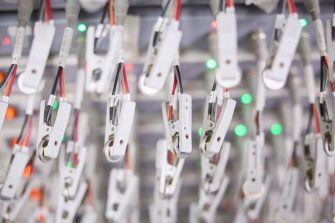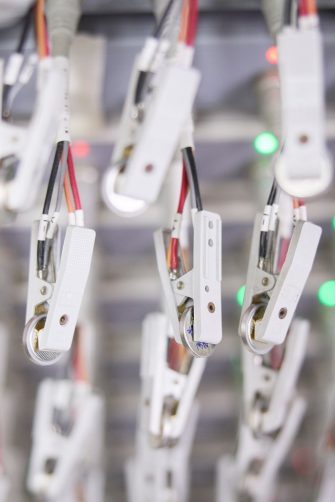Emerging battery technologies can help us transition toward a fossil fuel-free future.
A novel battery component that uses food-based acids found in sherbet and winemaking could make lithium-ion batteries more efficient, affordable and sustainable.
The prototype, developed and patented by UNSW chemists, reduces environmental impacts across its materials and processing inputs while increasing energy storage capability.
The single-layer pouch cell currently being optimised is similar to what you’d use in a mobile phone, only smaller, says lead researcher Professor Neeraj Sharma from UNSW Science.
“We’ve developed an electrode that can significantly increase the energy storage capability of lithium-ion batteries by replacing graphite with compounds derived from food acids, such as tartaric acid [that occurs naturally in many fruits] and malic acid [found in some fruits and wine extracts].”
Food acids are readily available, typically less aggressive and contain the necessary functional groups or chemical characteristics, he says.
“[Our battery component] could potentially use food acids from food waste streams, [reducing their environmental and economic impact]. Its processing uses water rather toxic solvents, so we’re improving the status quo across multiple areas.”
“By using waste produced at scale for battery components, the industry can diversify their inputs while addressing both environmental and sustainability concerns,” Prof. Sharma says.

Prof. Sharma leads the solid state and materials chemistry group, part of the cross-faculty batteries research community of practice at UNSW. They work with government and industry partners across all aspects of battery life.
“Our focus is to really understand the materials [used in batteries] and their mechanism during battery operation, and using this understanding we can design better materials,” he says.
“Our research ranges from synthesizing new materials, characterising new and commonly used materials and devices, to recycling and end-of-life degradation challenges.”
The need for batteries has only increased in recent years as we continue to develop renewable energy infrastructure to combat climate challenges, Prof. Sharma says.
“This is because replacing fossil fuel-based energy sources with renewable energy sources – for example, wind or solar – is contingent on our ability to store this energy that is generated intermittently.”
However, despite many advances, less than ten per cent of predicted global renewable energy storage requirements have been met.
“Using food acids to produce water-soluble metal dicarboxylates [electrode materials] presents a competitive alternative to graphite used in the majority of lithium-ion batteries that can, as we’ve demonstrated, optimise battery performance, renewability and cost to better support battery demand.”
By using waste produced at scale for battery components, the industry can diversify their inputs while addressing both environmental and sustainability concerns.
Current technological limitations demand innovation
Lithium-ion batteries make up the vast majority of our household and grid stationary battery energy storage, where excess solar energy is stored in battery systems.
However, the limitations of current technologies – relatively low storage capacities, expensive and environmentally unfriendly processes, and inaccessible materials – are slowing down battery uptake, he says.
Lithium-ion batteries predominantly use graphite anodes – conventionally termed the negative side of the battery. Graphite sources are relatively inaccessible and require mining, purifying and processing.
“About 60% of the graphite is lost in the processing steps, which typically require high temperatures and very strong acids [needed] to reach the required purity… so it has a massive environmental impact,” Prof. Sharma says.
While it’s likely technological advances in purification processes will help combat its high cost and enable the use of additional graphite sources, its limited capacity is unsurmountable, demanding innovation, he says.
“By understanding the chemistry of batteries, we can enhance their physical properties and improve their energy storage capacity [to hold more power], ionic conductivity [enabling higher rates of energy discharge or re-charge] or structural stability [extending their lifespan to improve sustainability].”
These pursuits improve the capabilities of real-world devices, from batteries thinner than human hair (microbatteries) that can be used for medical devices to packs of cylindrical or prismatic (rectangular in shape enabling efficient stacking) batteries that can store large amounts of electrical charge required for large trucks and large-scale industry applications.
First-year chemistry prompts patent
UNSW’s novel approach was driven by a PhD candidate examining reported inconsistencies in food acid performance in the lab.
“We realised the acid actually reacts with the metal surface [of the battery component]. It’s one of the first things we teach in first year chemistry – a metal plus an acid gives you a salt and hydrogen. And it’s that salt [that’s now been stabilised] that gives you that [improved] performance.”
The research team worked with a range of food acids and metals to identify the most affordable and materially accessible combination.
“We experimented to understand what was happening, designing reactions to maximise performance and characterising the resulting compounds and their performance,” he says.
“As a result, we have the versatility to change the combination to suit different supply streams and desired performance. For example, while we have got lots of iron in Australia, in other regions, manganese or zinc, for example, might be more accessible, and therefore these can be used as the metal component.”
The team are currently upscaling the technology, increasing production quantities, and transitioning from small coin cell to larger pouch cell capability. The next step will be running use/re-charge cycles at different temperatures to demonstrate industry viability and allow for further optimisation.
The technology is also applicable to sodium-ion batteries that present another cheaper, greener alternative to lithium-ion batteries.
The future of batteries is… coffee?
The research team are looking at diverting diverse bio-waste streams from landfill to use them as sources to formulate new electrode microstructures, Prof. Sharma says.
“For example, we’ve worked with Prof. Veena Sahajwalla to pyrolyse coffee grounds to [use them as a carbon source to] make anodes within lithium-sulphur batteries,” Prof. Sharma says. More than eight million tons of waste coffee grounds enter landfill globally every year.
Variations in quality caused by the supply chain, however, could affect consistency in energy storage capacity and safety aspects through unwanted side reactions, he says. “We’re working to identify what sort of variability a battery can handle.”
The end-of-life cycle for batteries – how they degrade, safety and sustainability considerations – is also a significant concern.
“Recycling is a really big challenge here. In ten to twenty years, we’re going to have a huge amount of the batteries from electric vehicles, scooters, power tools, and household and grid storage possibly coming offline.”
While some could potentially be repurposed as household, building or grid energy storage, many will need to be recycled, Prof. Sharma says. “At the moment, the [associated recycling] process is very energy-intensive, using harsh chemicals.”
Batteries of all kinds are sent to collection facilities. “Samsung batteries can be chemically very different to LG batteries to Tesla/Panasonic batteries, but they put them all together, grind them up and extract the metals, the stainless steel, copper and aluminium.
“The [remaining] black mass is shipped offshore … to be dropped back down to its pure elements. We’re asking are there clever routes to reuse that [mass] in new batteries, minimising the chemicals involved, [to create a closed loop].”
There isn't a single battery solution for all our needs, Prof. Sharma says. “It’s about having different battery technologies for different applications, including bringing solar and battery power together in one device.
“And asking how we can input more sustainable processes, use more sustainable materials to make it cheaper, better, faster, safer.”








